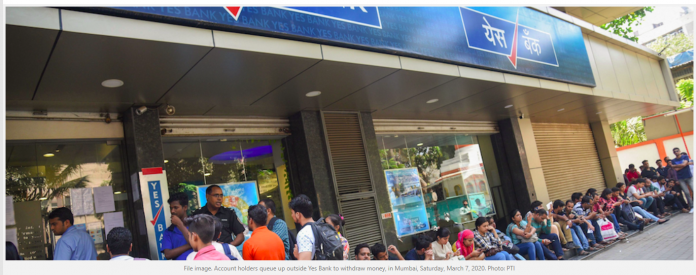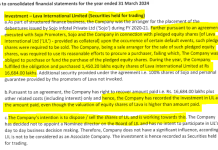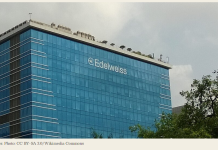The fact that the RBI supported the administrator’s actions in the court case indicates that, in all likelihood, it had orally instructed him to proceed.
On January 20, 2023, the Bombay high court dealt a body blow to Yes Bank. It set aside the decision of the then Administrator (and present Chief Executive Officer) Prashant Kumar to write down the bank’s Additional Tier 1 (AT1) bonds aggregating to Rs 84.15 billion.
This came even as the bank had seemed finally to be on a recovery path. While the present CEO may be made the scapegoat in this matter, the Reserve Bank of India (RBI) too has much to answer for.
There are three consequences of this judgement, which will most likely be appealed by Yes Bank at the Supreme Court.
First, shareholders in Yes Bank should be prepared for a huge loss and follow-on equity issue of around Rs 100 billion to recapitalise the bank if the Supreme Court of India reaffirms the Bombay high court judgment.
Secondly, even if the Supreme Court agrees with the Bombay high court judgement, the AT1 bondholders will not receive the past due interest (as the coupon is non-cumulative) till the bank declares a dividend on equity shares. This may take some years and as the bonds are perpetual, it is the bank’s discretion to exercise the call option.
Thirdly, in future bank collapses and reconstitutions, administrators must strictly follow the reconstitution scheme and get formal instructions from the banking regulator for any major decisions outside the reconstitution scheme.
If the Supreme Court of India reaffirms the Bombay HC judgment, Yes Bank’s Common Equity Tier 1 capital (CET1) will decline from the reported 13% as on the third quarter (3Q) of the financial year (FY) of 2023 to 9.9%.
This is factoring in (1) the AT1 bonds of Rs 84.15 billion and (2) the Rs 9.5 billion in share warrants and subscription money, which currently do not qualify as CET1.
Hence, to restore confidence with stakeholders, and as a prudent measure, the bank should raise further equity to compensate for the AT1 bonds.
| 3QFY2023 (Rupees in million) | Factoring AT1 | |
| 3QFY2023 CET1 | 315,900 | 315,900 |
| AT1 | 0 | -84,150 |
| Share warrants subscription money | 0 | 9,484 |
| CET1 Modified | 0 | 241,234 |
| Risk weighted assets | 2,430,000 | 2,430,000 |
| CET1 (%) | 13.0 | 9.9 |
Source: Yes Bank and HKH Research

Source: Yes Bank AT1 Prospectus
The accounting for the write-back of the AT1 bonds will be through the profit and loss account, as when it was written down, the bank’s income increased by Rs 84.15 billion in the financial year 2020, and hence Yes Bank will now have to report losses in such an event. In light of the Bombay HC judgment, it would have been prudent for the bank to provide for the amount in the 3QFY2023 results which was reported on January 21, 2023.

Source: Yes Bank FY2020 Annual Report p. 218
Indicting the administrator, the Bombay HC judgment holds:
“One more aspect that requires consideration is that the Yes Bank stood reconstituted on March 13, 2020, upon the Notification of the final Yes Bank Ltd. Reconstruction Scheme, 2020. After the bank was reconstituted, the Administrator could not have taken such a policy decision of writing off the debentures.” [emphasis added]
Further castigating the Administrator, the judges asserted:
“During this period, the Administrator could not have taken such a policy decision of writing down the AT-1 bonds. Nor the RBI had authorized him to do so. The Final Reconstruction Scheme also did not authorize Administrator to write off the AT-1 bonds. It appears that Administrator exceeded his powers and authority in writing off AT-1 bonds after the bank was reconstructed on March 13, 2020.”
The Union government had imposed a moratorium on Yes Bank from 6 pm on March 5, 2020, and Prashant Kumar was appointed as the administrator.
On March 6, the RBI issued a Draft Scheme of Reconstruction for Yes Bank, which stated that all AT1 bonds of Yes Bank issued under Basel III would be written down. On March 13, 2020, the final scheme was notified and came into force; the final scheme deleted the condition that AT1 bonds would be written down. However, a day later, on March 14, 2020, the administrator wrote down Rs 84.15 billion of AT1 bonds issued under Basel III norms. On March 19, 2020 two officials from State Bank of India were appointed as directors of the bank, and on March 20, 2020, the RBI too appointed two directors on the bank’s board.
It would have been highly unusual for an administrator who had been suddenly parachuted from outside to have single-handedly taken such a bold and strategic decision as writing down Rs 84.15 billion in ATI bonds within days of taking charge, without getting an approval from the RBI.
Also read: YES Bank Case: CEO Says Bank ‘Out of the Woods’; Will Distance Itself from Large Corporate Borrowers
The very fact that the Bombay HC judgment records that the advocate representing the regulator stated that the decision to write down the ATI bonds was “lawful” and “necessary” to protect Yes Bank’s depositors indicates that the decision had the support of the RBI. But, in a major contradiction, the Bombay HC judgement also emphatically states that the regulator did not issue any instructions to the administrator to write down the AT1 bonds, and hence the responsibility of the decision lay squarely on the administrator. In this, it bases itself on the RBI’s submission.
Effectively, the RBI publicly hung the Yes Bank administrator out to dry. He will be made the scapegoat if the Supreme Court also reaffirms the Bombay HC’s decision.
On page 48 of the judgment, the court says:
“Hence, the bonds continue to remain subject to the Master Circular and continue to be open for write-off. The write-off was lawful but also necessary for ensuring protection of more than two lakh depositors/individual account holders.”
It then says:
“The learned advocate for the respondent, Reserve Bank of India, submit that though under section 36 ACA, the RBI may issue such directions to the Administrator as it may deem appropriate, but RBI has not issued any directions to the administrator to write down the AT-1 bonds.”
The role of the RBI as the banking regulator in this particular instance is less than stellar. The condition of writing down AT1 bonds was present in the draft scheme; so when the final scheme excluded this condition, it indicated that the RBI or the government had some reservations on the legality of the write-down.
Hence either the RBI should have advised the administrator not to proceed with the write-down, or Prashant Kumar should have demanded that the RBI formally issue directions to write down the bonds. The fact that the RBI supported the administrator’s actions in the court case indicates that, in all likelihood, it had orally instructed him to proceed. At the same time, however, it did not want to be formally identified as the author of the instruction, and hence it stated that no formal instructions were given.
If the Supreme Court of India reaffirms the Bombay HC’s judgment, the AT1 bond holders will not get relief in terms of interest as well as in getting back their principal till the bank declares a dividend on equity shares and only the administrator’s reputation will be affected, and not that of the Reserve Bank of India – a lesson that future administrators and AT1 bond holders would do well to remember.
Hemindra Hazari is an independent banking analyst and can be reached at hkh@hemindrahazari.com.
Disclosure:
I, Hemindra Hazari, am a Securities and Exchange Board of India (SEBI) registered independent research analyst (Regd. No. INH000000594). I own equity shares in Yes Bank. Views expressed in this Insight accurately reflect my personal opinion about the referenced securities and issuers and/or other subject matter as appropriate. This Insight does not contain and is not based on any non-public, material information. To the best of my knowledge, the views expressed in this Insight comply with Indian law as well as applicable law in the country from which it is posted. I have not been commissioned to write this Insight or hold any specific opinion on the securities referenced therein. This Insight is for informational purposes only and is not intended to provide financial, investment or other professional advice. It should not be construed as an offer to sell, a solicitation of an offer to buy, or a recommendation for any security.














